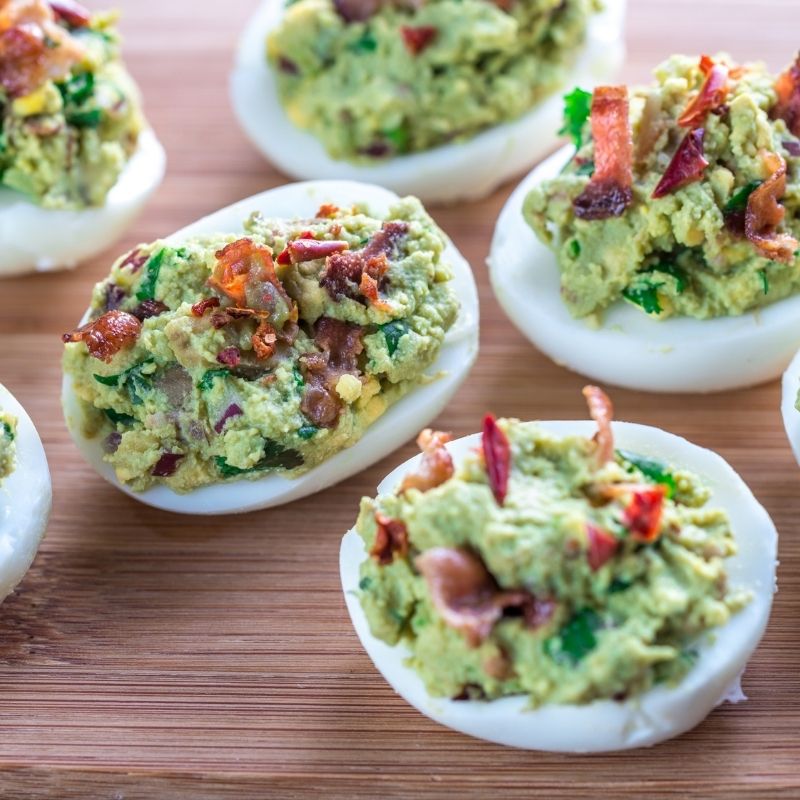It is said that the egg is one of the most loyal ingredients in the kitchen since it can produce hundreds of different and delicious recipes.
One of these popular egg recipes is the Huevos Rellenos, also known as Spanish deviled eggs. A part of the popularity of these Spanish eggs is that they are cheap to make, and it takes less than an hour to get them done.
Keep reading because in this article I’ll tell you about the deviled eggs’ history, different ways of serving them, and all of the replacements that you can make for this Spanish lunch recipe.

You, dear reader, support this blog. If you purchase through a link, we earn a small commission. As an Amazon Affiliate, we earn from qualifying purchases.
Background of the Dish

Even though this dish is popular all around the world, the deviled eggs’ origin took place in Andalusia, Southern Spain.
The first recipe for what we know today as deviled eggs was written in a cookbook from Andalusia of the 13th century.
Of course, the recipe underwent multiple changes, mostly because mayonnaise wasn’t used as it is today.
Despite that, it was made with a similar sauce named “Murri” (fermented fish or barley), and that’s what the present-day recipe calls for tuna.
Nowadays you can find this dish at any restaurant in Spain, and every household has its unique recipe.
There are some fancy deviled eggs recipes that call for salmon or even caviar, but in this case, we are sticking with the classic tuna, eggs, and mayonnaise.
Pin for later!

Things You’ll Need for Spanish Deviled Eggs
To make these Spanish Deviled eggs you’ll only need two key ingredients; tuna and eggs. The other ingredients can be substituted and in some cases completely eliminated.
When it comes to kitchen tools, it’s better if you have a potato masher since it’ll make the job easier. But of course, you can use a fork and it’ll work just as well.

Ingredients
- 8 eggs
- 1 can (150g) tuna in olive oil
- 10 olives (pitted)
- 5 tablespoons mayonnaise
- 1 teaspoon salt
- 1 teaspoon smoked paprika
- 1/2 teaspoon black pepper.
How to Make Spanish Deviled Eggs – Step by Step Guide

- To start with this Spanish appetizers recipe, cook the eggs in boiling water for about 10 minutes. Then take them to a bowl with cold water so they cool quickly and it is easier to remove the shell.
- Then cut the eggs into halves, carefully remove the yolk, and put it aside in a separate bowl.
- After that, open the can of tuna and drain to remove the excess liquid. Grab a large bowl to prepare the filling and put the tuna there.
- For the next step, chop the olives very finely (it is better if you use the ones without the pit). You can chop it into irregular sizes as it doesn’t matter.
- Cut the egg yolks so it is easier to mix everything and put them in the filling bowl. Add the mayonnaise, salt, paprika, and pepper. Start mashing everything with a fork. Once you have a smooth and homogeneous mixture, the filling is ready.
- Now it’s time to fill the whites. You can use a tablespoon and use the same measure for all eggs (1 to two tablespoons), or use a piping bag to make them look better aesthetically.
- As an optional step, you can sprinkle a little paprika or chopped chives on top to decorate. Put them in the fridge for 30 minutes before eating your egg appetizers (you can avoid this step and eat them at room temperature).
Substitution of Ingredients

My favorite part about making simple egg recipes is that you can make hundreds of replacements and adapt the recipe to your personal tastes and what you have available in your home.
Thankfully the Spanish deviled eggs recipe is not an exception.
For example, you can make deviled eggs without mayo, if you replace it with cream cheese, sour cream, aioli, or basically any sauce that has the same consistency.
If you are looking for healthy deviled eggs, you can use low-fat cream cheese or any other light mayo that you can find in your local store.
If you liked this recipe then I encourage you to try other Spanish recipes, such as Spanish meatballs recipe, Spanish chicken croquettes, Berenjenas Fritas con Miel, and Cazon en Adobo.
Tips on Serving Spanish Deviled Eggs

If you are walking in the streets of any part of Andalusia, you’ll notice that every tapas bar serves this dish at any time of the day.
With that being said, you can serve a deviled egg platter for lunch, an afternoon snack, or dinner.
The Spanish deviled eggs are considered to be one of the most loved tapas in all of Spain. You might be asking yourself what are tapas?
Well, that’s very simple, the best Spanish tapas are dishes that work as starters for a meal, and they are easy to eat in one bite.
These Spanish eggs make for the perfect starter since if you eat a small amount you won’t be completely filled and you’ll have room for more food.
The Spanish stuffed peppers recipe is a must-try since the pepper is filled with tuna as well and they are very delicious tapas.
Try the huevos a la flamenca recipe if you want a nutritious meal with eggs, potatoes, and chorizo.
How to Store Spanish Deviled Eggs

If you are making these Spanish appetizers, it is very important that you keep in mind that they can only be stored for 3 days in the fridge.
This is because otherwise the egg will harden, and the flavor will be too strong and not pleasant at all. So if you have any leftovers, you can either store them for up to 3 days in the fridge or use them for other Spanish appetizers recipes.
Among other things to make with eggs, you could chop them into quarters and put them in salads or soups.
Recipe Card: Spanish Deviled Eggs
Spanish Deviled Eggs Recipe

It is said that the egg is one of the most loyal ingredients in the kitchen since it can produce hundreds of different and delicious recipes.
One of these popular egg recipes is the Huevos Rellenos, also known as Spanish deviled eggs.
A part of the popularity of these Spanish eggs is since they are cheap to make, and it takes less than an hour to get them done.
Ingredients
- 8 eggs
- 1 can (150g) tuna in olive oil
- 10 olives (pitted)
- 5 tablespoons mayonnaise
- 1 teaspoon salt
- 1 teaspoon smoked paprika
- 1/2 teaspoon black pepper.
Instructions
- First, cook the eggs in water that is already boiling, for about 10 minutes. Then take them to a bowl with cold water so they cool quickly and it is easier to remove the shell.
- Cut them into halves, carefully remove the yolk, and put it aside in a separate bowl.
- Open the can of tuna and drain to remove the excess liquid. Grab a large bowl to prepare the filling and put the tuna there.
- Chop the olives very finely (it is better if you use the ones without the pit). You can chop it into irregular sizes as it doesn't matter.
- Cut the egg yolks so it is easier to join everything and put them in the filling bowl. Add the mayonnaise, salt, paprika, and pepper. Start mashing everything with a fork. Once you have a smooth and homogeneous mixture, the filling is ready.
- It is time to fill the whites. You can use a tablespoon and use the same measure for all eggs (1 to two tablespoons), or use a piping bag to make them look better aesthetically.
- As an optional step, you can sprinkle a little paprika or chopped chives on top to decorate. Put them in the fridge for 30 minutes before eating (you can avoid this step and eat them at room temperature).
Notes
I prefer to let the deviled eggs cool in the fridge for 30 minutes or one hour before eating them, but you can serve them at room temperature.
Pepper, paprika, and salt are the classic seasonings, but feel free to try others such as turmeric or even different herbs like parsley, rosemary, etc.
Nutrition Information
Yield
4Serving Size
1Amount Per Serving Calories 193Total Fat 14gSaturated Fat 3gCholesterol 195mgSodium 344mgCarbohydrates 1gFiber 1gSugar 0gProtein 15g



Hola, I’m Paulina! Together with my team, we are passionate about Southern Spain. Here we share all you need to know for great times in Southern Spain with the best places to visit, stay and, of course, the best food to eat.
Let’s dive in and explore Southern Spain’s outdoors, food and culture con pasión!

